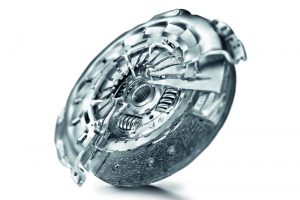
Mark Dolloway, Sales Director at Schaeffler UK, explains to PMF how self-adjusting clutches (SACs) can be a distress purchase for garages and why this means it is important for factors to stock the right part numbers, depending on the vehicle car parc in the local area.
Q. What is it about SACs that means they are often distress purchases for garages?
 Mark Dollaway (MD): Virtually every clutch replacement is a distress purchase, made because gear changes have become very difficult due to advanced wear or failure. No planned service intervals exist for clutch systems – because every single vehicle has a different driver using different driving styles, clutches wear at different rates and in different ways. There are technical differences between conventional and self-adjusting clutches that make it more difficult to predict wear, which I will go on to explain.
Mark Dollaway (MD): Virtually every clutch replacement is a distress purchase, made because gear changes have become very difficult due to advanced wear or failure. No planned service intervals exist for clutch systems – because every single vehicle has a different driver using different driving styles, clutches wear at different rates and in different ways. There are technical differences between conventional and self-adjusting clutches that make it more difficult to predict wear, which I will go on to explain.
Q. How do conventional and self- adjusting clutches differ? And how can you tell when they’re worn?
MD: LuK SACs are the vehicle manufacturers’ solution for enhanced driveability and durability in today’s high torque engines. An SAC works by continuously compensating for the increased clutch pedal load due to changes in the diaphragm spring geometry, caused by drive plate friction wear. Short distance commuters may not notice this increase until a new clutch is fitted, restoring a lower pedal load. However, business or van drivers who change gear hundreds of times a day will definitely be working extra hard to make a smooth progression.
The SACs’ ability to maintain the geometry and consistent, lighter pedal load effectively reduces friction wear, whilst extending the service lifetime of the clutch and its associated components.
You know when a conventional clutch is worn because the pedal biting point becomes very high and heavy to operate, and eventually the clutch will start to slip. SACs maintain the geometry and load, and, therefore, a light and responsive pedal feel for the entire clutch lifetime – meaning there is no obvious or discernible wear warning, other than on the pedal, which will have a hard stop point at the end of its travel, and gradually becomes higher as the clutch becomes more worn. If the hard stop is ignored, then the clutch will, eventually, start to slip.
Q. What is the average service life of an SAC?
MD: An added benefit of the SAC is that the average clutch life expectancy is extended compared to a non-SAC clutch, and even those claiming to be an alternative to the originally fitted SAC unit.
Q. How can Schaeffler help factors keep track of their local car parc and, therefore, the correct SAC part numbers?
MD: Motor factors should stay on top of their stock profile. Schaeffler works with its distributors to make sure they regularly reprofile and cleanse their stocks to match sales and the regional vehicle parc usage.
Q. Who does this service apply to?
MD: Schaeffler offers a regular service to all of its distributors throughout the UK and Ireland – employing strategists and reprofiling experts to keep ahead of regional trends. We are continuously monitoring and updating all of our data so that every customer gets the best possible stock profile.
Q. Are there any noticeable trends dependent on geographical area, say the difference between urban and rural location?
MD: Schaeffler has access to the latest accurate regional parc information, but it is also important that motor factors provide existing sales data, which helps us to identify their local ‘customer parc’ rather than the ‘vehicle parc’ – so that we can more accurately service their actual customer base.







